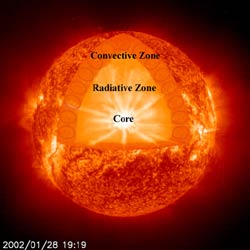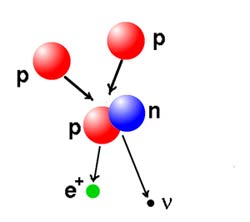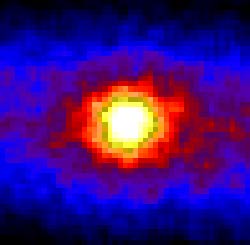
Sun-Earth Day 2007 presents: Living in the Atmosphere of the Sun
Only during the last 70 years has the secret to solar power been uncovered.
ISSUE #49: SOLAR ENERGY

A cut-away of the solar interior showing the core ,radiative zone and convection zone. (Courtesy: NASA-SOHO)
Story:
For thousands of years it was thought that the brilliant light from the sun and its dazzling warmth were simply an inscrutable physical property of the matter from which it was formed. Some even called it the Fifth Essence: Ether.
Once alchemists and chemists began to understand how substances combined and 'burned', it was thought that the sun was quite literally a ball of matter that was chemically burning in space. However, from the estimated dimensions of the sun ,and the typical output of heat and light from the best chemical reactions, the sun could only survive for thousands of years. By the 1800's, this was badly at-odds with geologists such as Charles Lyell (1797-1875) who estimated that many geological forms were as much as 100 million years old. How could Earth be older than the mighty sun itself?
In 1854, Hermann von Helmholtz (1821 - 1894) proposed an ingenious way out of this geological contradiction. As the sun lost energy, gravity would cause it to shrink slightly. The infall would heat up the interior slightly, causing the sun to return to equilibrium at a slightly smaller size. But over long periods of time, it would continue to collapse and give up its heat energy to space. By the 1897, however, Lord Kelvin (1824-1907) estimated that the sun could live about 30 million years and shine in this way, unfortunately, geologists by this time had improved their estimates for earth's age and came up with the staggering number of 2 billion years! What was missing was 'new physics'.

In Step 1 of the Proton-Proton Cycle, two protons collide to produce a deuterium nucleus.
As physicists began to understand radioactivity and quantum mechanics better during the 1920's, Sir Arthur Eddington (1882-1924) speculated that some form of 'sub-atomic energy' within the vast hydrogen reserves in the sun's core might be a likely source of energy.
Between 1931 and 1937, physicists Robert Atkinson (1898-1982) Carl von Weizsäcker (b. 1912) and George Gamow (1904-1968) published a research that discussed the fusion of hydrogen into helium as a possible source of energy, but no one knew how to do the calculations to determine how much energy, or for how long the sun might survive by this mechanism.

In the next step, a proton and a deuterium nucleus collide to produce a nucleus of Tritium.
In 1939, physicist Hans Bethe (1907-2005) figured out how the fusion idea would actually work, and published the first extensive and quantified calculations for the 'proton-proton' (PP) and 'carbon-nitrogen-oxygen' (CNO) cycles that occur within the sun and other stars. The PP-cycle provided 98% of the energy of the sun at the typical temperature of the sun's core: about 15 million degrees. The solar CNO-cycle provides about 2% of the energy through a more complex series of nuclear reactions.

In the last step, two tritium nuclei collide to produce a helium nucleus and two ejected protons to start the cycle over again.
The PP-cycle takes two colliding hydrogen nuclei (protons) and fuses them into a deuterium nucleus. A third proton collides with the deuterium nucleus to make a tritium nucleus. Then two tritium nuclei fuse to produce a single helium nucleus, and eject two protons to start the cycle again. Each of these steps takes a specific amount of time .The slowest step is the first one which takes about one billion years! The production of a tritium nucleus takes about 6 seconds, and a helium nucleus is formed once every million years. Additional particles called neutrinos are produced in these reactions.
In 2003, a team of scientists using the Super Kamiokande neutrino detector in Japan, and the Sudbury Neutrino Observatory in Canada succeeded in detecting all of the different types of solar neutrinos, putting to rest a controversy over the 'missing neutrinos' that had continued for nearly 40 years. These neutrinos completely confirm the 70-year-old prediction that nuclear fusion powers the sun, and therefore, all the other luminous stars in the sky!

An image of the sun taken with neutrinos that are streaming out of the hot core, proves that nuclear fusion is actually taking place. (Courtesy: R. Svoboda - Louisiana State University)
To generate the sun's energy, about 4 x 10^27 Watts, approximately 600 million tons of hydrogen have to be fused every second! Approximately 4 million tons of matter is converted into pure energy every second, and only about 10% of the sun is hot enough for fusion to occur. This region is defined to be the solar core. The sun can continue fusing hydrogen into helium for about 12 billion years, so since it is now 4.5 billion years old, it can continue to shine for another 7 billion years! Hydrogen fusion solves the Earth-Sun timescale problem because now the sun is comfortably of the same age as Earth. In the future, however, Earth will be come uninhabitable as the sun continues to evolve as a star.
RELATED LINKS
Technology Through Time
2007 ISSUES
- #57: The Heliosphere
- #56: Coronal Mass Ejections
- #55: Solar Corona, Holes and Wind
- #54: Solar Flares... Oh my!
- #53: Solar Prominences
- #52: Sunspots from A to B - solar magnetism
- #51: The Transit of Mercury
- #50: Ancient Sunlight
- #49: Solar Energy
- #48: The Sun: From Cradle to Grave
View past issues
Authors and Designers
Space Weather Fact
Earth's climate was seriously chilled during the Maunder Minimum (1645-1715) when no 11-year sunspot cycles were detected.


